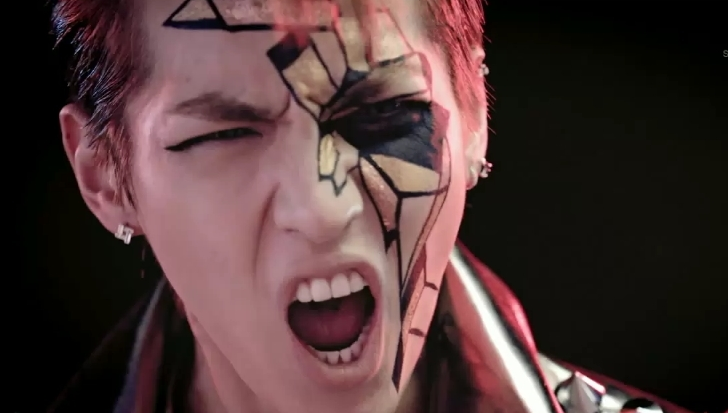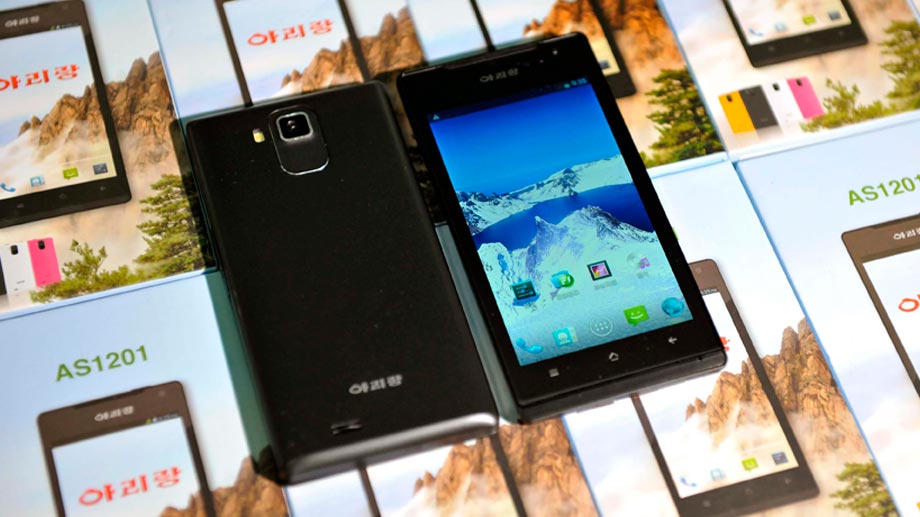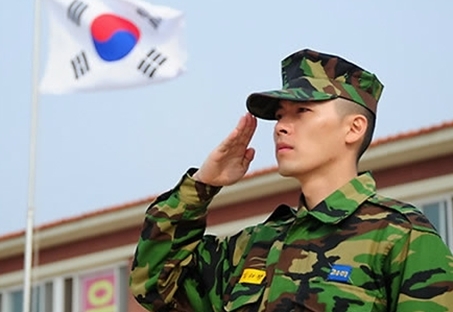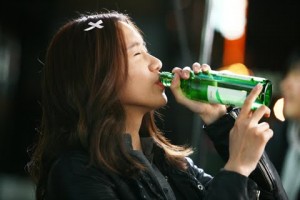 Avid fans of Korean entertainment will be well aware of the slim green bottle filled with clear liquid. It makes its appearance in many forms, especially in dramas and movies; sometimes, it will sit near a babbling and/or sobbing woman who will naturally need to be carried off to safety by some handsome leading man, while other times it is found in abundance alongside middle-aged men who sit together at a restaurant, gradually growing louder and more merry until a fight inevitably breaks out. Occasionally you’ll see Lee Hyori or UEE waving one around and looking entirely too happy for someone who is probably going to have a raging hangover in the morning. Of course, I am talking about soju, my friends — the Korean liquor of choice, an alcoholic product traditionally made from rice and often consumed neat (i.e. straight, without ice, without mixing, no frills). Soju is at the root of most adult social gatherings and 99% of bad decisions made in Korean dramas (hyperbole intended, but you get the point).
Avid fans of Korean entertainment will be well aware of the slim green bottle filled with clear liquid. It makes its appearance in many forms, especially in dramas and movies; sometimes, it will sit near a babbling and/or sobbing woman who will naturally need to be carried off to safety by some handsome leading man, while other times it is found in abundance alongside middle-aged men who sit together at a restaurant, gradually growing louder and more merry until a fight inevitably breaks out. Occasionally you’ll see Lee Hyori or UEE waving one around and looking entirely too happy for someone who is probably going to have a raging hangover in the morning. Of course, I am talking about soju, my friends — the Korean liquor of choice, an alcoholic product traditionally made from rice and often consumed neat (i.e. straight, without ice, without mixing, no frills). Soju is at the root of most adult social gatherings and 99% of bad decisions made in Korean dramas (hyperbole intended, but you get the point).
Dramas and movies might present comically exaggerated scenarios involving soju and the consumption of alcohol, but they are undeniably grounded in reality. So let’s talk drinking for a hot minute, shall we?
Korean drinking culture is actually far more than simply drinking until one can’t communicate. Implicit in drinking culture are social norms that deal with age, seniority, and relationships between family members, work colleagues, and friends. Remember how there are different speech levels in the Korean language that must be used depending on one’s relationship to an interlocutor? Drinking culture is kind of similar; how you drink depends on who you are drinking with, why you are drinking, where you are drinking, and sometimes even what you are drinking. So if you’re a K-pop fan, here’s a quick guide to the drinking culture that you’ll encounter in your favorite dramas, movies, and variety shows.
Let’s start off with the alcohol itself. We’ve already covered the infamous soju, which is perhaps the easiest to spot, but what else are Koreans drinking?
- Beer, of course. Beer is very popular in South Korea, and there are a number of Korea-specific brands that you likely won’t find anywhere else (unless you’re in a Korean restaurant). Beer is often paired with fried chicken at restaurants called hof (borrowed from the German language). Sometimes, South Koreans will drop a shot of soju into a glass of beer and drink the whole thing in one shot; this is known as poktanju and is essentially the Korean version of a sake bomb (Gyeon-woo drinks one of these in My Sassy Girl while he and The Girl are celebrating their 100 day anniversary). When watching Korean television, either keep an eye out for giant pitchers of the stuff or listen for maek-ju — the Korean word for “beer.”
- Baekseju, or “100-years wine.” Baekseju is another alcoholic beverage made from rice and flavored with herbs, which is ironically how it gets its
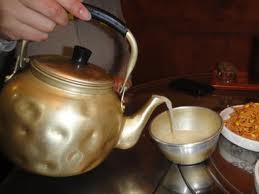 name — the herbs used to make the beverage are supposed to contribute to health so that one can live for 100 years. Baekseju is usually served in a soju-sized bottle, but is yellowish in color.
name — the herbs used to make the beverage are supposed to contribute to health so that one can live for 100 years. Baekseju is usually served in a soju-sized bottle, but is yellowish in color. - Makkoli, Korean rice wine. Makkoli is often served in what appear to be large teapots and consumed out of bowls. It pairs especially well with Korean scallion pancakes (called pajeon) and isn’t quite as harsh-tasting as is soju, which is sometimes compared to rubbing alcohol in terms of taste and smell.
The above list is by no means complete, but these beverages are perhaps the most common. Koreans will also occasionally (and with greater frequency these days) drink wine, too, but unless you’re eating Korean barbecue, wine might be an odd choice — my friends and I generally agree that most Korean soups and stews taste horrible with a wine accompaniment. Your mileage may vary.
Koreans drink in all sorts of social circumstances; a bottle of soju will almost certainly break the ice or make merrier any sort of gathering between friends and family members. However, alcohol also plays a large role in work culture in South Korea. Workplaces can be dominated by excessive displays of formality that prevent friendships (or even polite acquaintanceships) from forming, so departments will often hold mandatory group dinners, called hwae-shik, for colleagues to relax and get to know each other after work has ended. Hwae-shik are infamous for the involvement of alcohol, largely because it helps to break down the social barriers present in the office — and often the youngest or newest workers in the department will be the drunkest after the evening has ended (only after much cajoling from older or more senior employees, of course). Hwae-shik horror stories are a dime a dozen, for they often result in male breadwinners staying out all night and arriving home drunk to their wives and children — but that’s another blog post. I’m sure you’ll be able to spot a hwae-shik taking place in a drama near you with very little difficulty.
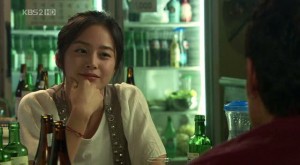 Korean students will often drink in events organized by school organizations, called MT in Korean. Like hwae-shik, MT are intended for new students and older students to have the opportunity to mingle and get to know one another in a less rigid environment. Unfortunately, there is often an element of hazing implicit in many MTs, and you can probably guess which students wind up being the victims. New students will often be asked how much they can drink and then put to the test. The standards do vary in terms of how much men and women are expected to drink, but drinking is by no means limited to males only.
Korean students will often drink in events organized by school organizations, called MT in Korean. Like hwae-shik, MT are intended for new students and older students to have the opportunity to mingle and get to know one another in a less rigid environment. Unfortunately, there is often an element of hazing implicit in many MTs, and you can probably guess which students wind up being the victims. New students will often be asked how much they can drink and then put to the test. The standards do vary in terms of how much men and women are expected to drink, but drinking is by no means limited to males only.
Perhaps unsurprisingly, Korean drinking culture has a set of rules to follow, all of which you should be able to spot in your favorite movie or drama (and all of which you yourself should follow should you ever find yourself in a drinking situation with Korean friends or colleagues!). The dos-and-don’ts of drinking culture are as follows:
- Even if one doesn’t want to drink, one should accept a glass or shot of alcohol if it is given to them. It’s not a terribly good idea to make friends with pushy people who will force you to do things you don’t want to do, but outright turning down alcohol is (unfortunately) generally considered to be rude in South Korea.
- When everyone does a shot, do a shot. If you really don’t want to drink, at least sip it.
- If the person handing one a shot or drink is older, one should accept the drink with both hands.
- One should never re-fill one’s own glass or let others re-fill their own glasses. Allow others to fill your glass by holding it out with two hands (especially important if the person filling it is older or holds a greater degree of seniority). Fill the glasses of others — and don’t forget to use both hands!
- When drinking with older people, one should never do a shot directly facing an older or more senior person. Turn to the side or turn around to drink your shot. A great example of this can be seen in My Sassy Girl, when Gyeon-woo accepts a shot of soju from The Girl’s father. He turns to one side to drink it, but finds The Girl’s mother to be sitting to his right — and thus has to turn the other way in order to drink it.
- When doing a shot, don’t forget to say keon-bae! — that’s essentially Korean for “Cheers!”
Though there is much more that could be said about Korean drinking culture, we hope that you’re a little less in the dark after reading this post! Questions or comments? Leave them below — and easy on the soju in the meantime, okay?
